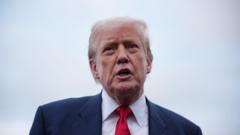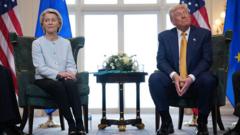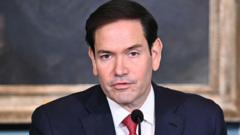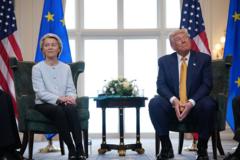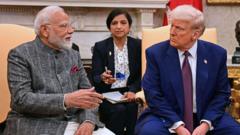Trump's recent tariffs have brought a mix of short-term economic reassurance and long-term global trade uncertainties.
Trump's Tariff Policies: Economic Wins or Hidden Costs?

Trump's Tariff Policies: Economic Wins or Hidden Costs?
President Trump's Imposed Tariffs Spark Global Trade Unease
In April, President Donald Trump surprised global markets with announcements of sweeping new import tariffs, though he later rolled back many of them following a significant financial panic. Fast forward four months, and Trump is now celebrating what he touts as victories—claiming success in securing new trade agreements with some countries while imposing unilateral tariffs on others, all without triggering another major market disturbance, at least for now.
There is burgeoning optimism that these tariffs will lead to increased government revenue, rejuvenate domestic manufacturing, and spur billions in foreign investments and purchases. However, whether these anticipated benefits will materialize remains uncertain, and the long-term consequences of his trade strategies could be different than currently envisioned. Notably, a more decisive trend away from free trade seems to be developing across the globe, which might just be an ominous precursor to the ramifications that could surface later.
Set against this backdrop, many international policymakers marked August 1 with trepidation—countries were warned to agree to new trading terms with the US by that date or face potentially disastrous tariffs. Trump’s trade advisor predicted an ambitious "90 deals in 90 days," yet as the deadline arrived, only a handful of agreements had been established, many lacking the comprehensive details typically expected in trade negotiations.
The United Kingdom was among the first to adapt, receiving a baseline tariff of 10% on most goods, viewed with some relief compared to the higher rates facing others like the EU and Japan. The drastic shift in tariff structure has left numerous countries reevaluating their trading partnerships amidst fears of punitive measures.
Despite having avoided the worst fears of a global recession and the most severe economic fallout, emerging patterns are now evident. Certainty in tariff terms, while a double-edged sword, has given businesses some leeway to adjust pricing and operations, infusing a calmer atmosphere into US financial markets. Yet, the broader implications are complex; higher tariffs have generally elevated costs and can risk downstream economic growth if households and international demand are squeezed.
Countries like India are feeling the mixed impacts of tariffs, with projected tariffs on their exports potentially exceeding 25%, though the overall economic implications may be minimal due to the relatively small share of US demand in their GDP. Conversely, Germany's automotive sector faces significant challenges from the newly elevated tariffs, risking its growth prospects amid a potential recession.
While some nations, like India, have begun shifting their production strategies to align with new realities, uncertainty looms large for others still waiting on agreements, particularly Canada and Taiwan. The long-term stability of relationships with key trading partners like the EU may be at risk as they reassess the reliability of the US as an ally.
President Trump’s aim remains to enhance domestic production and job creation; however, the degree of success in achieving these ambitious objectives remains in question. The immediate impacts may have prompted relief, yet analysts warn that the true effects of altered global trade dynamics will unfold slowly over years.
Ultimately, American consumers might bear the burden of these tariff policies, facing rising prices and a potential dip in economic growth. Should Trump proceed with plans to issue rebate checks to offset consumer costs, the political implications could grow more complex leading up to next year's midterm elections.
In the shifting landscape of international trade, the consequences of Trump's tariff policies are yet to be fully quantified, but the reverberations may reshape global economic alliances for years to come.
There is burgeoning optimism that these tariffs will lead to increased government revenue, rejuvenate domestic manufacturing, and spur billions in foreign investments and purchases. However, whether these anticipated benefits will materialize remains uncertain, and the long-term consequences of his trade strategies could be different than currently envisioned. Notably, a more decisive trend away from free trade seems to be developing across the globe, which might just be an ominous precursor to the ramifications that could surface later.
Set against this backdrop, many international policymakers marked August 1 with trepidation—countries were warned to agree to new trading terms with the US by that date or face potentially disastrous tariffs. Trump’s trade advisor predicted an ambitious "90 deals in 90 days," yet as the deadline arrived, only a handful of agreements had been established, many lacking the comprehensive details typically expected in trade negotiations.
The United Kingdom was among the first to adapt, receiving a baseline tariff of 10% on most goods, viewed with some relief compared to the higher rates facing others like the EU and Japan. The drastic shift in tariff structure has left numerous countries reevaluating their trading partnerships amidst fears of punitive measures.
Despite having avoided the worst fears of a global recession and the most severe economic fallout, emerging patterns are now evident. Certainty in tariff terms, while a double-edged sword, has given businesses some leeway to adjust pricing and operations, infusing a calmer atmosphere into US financial markets. Yet, the broader implications are complex; higher tariffs have generally elevated costs and can risk downstream economic growth if households and international demand are squeezed.
Countries like India are feeling the mixed impacts of tariffs, with projected tariffs on their exports potentially exceeding 25%, though the overall economic implications may be minimal due to the relatively small share of US demand in their GDP. Conversely, Germany's automotive sector faces significant challenges from the newly elevated tariffs, risking its growth prospects amid a potential recession.
While some nations, like India, have begun shifting their production strategies to align with new realities, uncertainty looms large for others still waiting on agreements, particularly Canada and Taiwan. The long-term stability of relationships with key trading partners like the EU may be at risk as they reassess the reliability of the US as an ally.
President Trump’s aim remains to enhance domestic production and job creation; however, the degree of success in achieving these ambitious objectives remains in question. The immediate impacts may have prompted relief, yet analysts warn that the true effects of altered global trade dynamics will unfold slowly over years.
Ultimately, American consumers might bear the burden of these tariff policies, facing rising prices and a potential dip in economic growth. Should Trump proceed with plans to issue rebate checks to offset consumer costs, the political implications could grow more complex leading up to next year's midterm elections.
In the shifting landscape of international trade, the consequences of Trump's tariff policies are yet to be fully quantified, but the reverberations may reshape global economic alliances for years to come.



